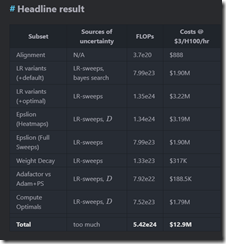Apple Does Not Just Take Money from Google
August 12, 2024
In an apparent snub to Nvidia, reports MacRumors, “Apple Used Google Tensor Chips to Develop Apple Intelligence.” The decision to go with Google’s TPUv5p chips over Nvidia’s hardware is surprising, since Nvidia has been dominating the AI processor market. (Though some suggest that will soon change.) Citing Apple’s paper on the subject, writer Hartley Charlton reveals:
“The paper reveals that Apple utilized 2,048 of Google’s TPUv5p chips to build AI models and 8,192 TPUv4 processors for server AI models. The research paper does not mention Nvidia explicitly, but the absence of any reference to Nvidia’s hardware in the description of Apple’s AI infrastructure is telling and this omission suggests a deliberate choice to favor Google’s technology. The decision is noteworthy given Nvidia’s dominance in the AI processor market and since Apple very rarely discloses its hardware choices for development purposes. Nvidia’s GPUs are highly sought after for AI applications due to their performance and efficiency. Unlike Nvidia, which sells its chips and systems as standalone products, Google provides access to its TPUs through cloud services. Customers using Google’s TPUs have to develop their software within Google’s ecosystem, which offers integrated tools and services to streamline the development and deployment of AI models. In the paper, Apple’s engineers explain that the TPUs allowed them to train large, sophisticated AI models efficiently. They describe how Google’s TPUs are organized into large clusters, enabling the processing power necessary for training Apple’s AI models.”
Over the next two years, Apple says, it plans to spend $5 billion in AI server enhancements. The paper gives a nod to ethics, promising no private user data is used to train its AI models. Instead, it uses publicly available web data and licensed content, curated to protect user privacy. That is good. Now what about the astronomical power and water consumption? Apple has no reassuring words for us there. Is it because Apple is paying Google, not just taking money from Google?
Cynthia Murrell, August 12, 2024
Podcasts 2024: The Long Tail Is a Killer
August 9, 2024
![green-dino_thumb_thumb_thumb_thumb_t[2] green-dino_thumb_thumb_thumb_thumb_t[2]](https://arnoldit.com/wordpress/wp-content/uploads/2024/07/green-dino_thumb_thumb_thumb_thumb_t2_thumb.gif) This essay is the work of a dumb humanoid. No smart software required.
This essay is the work of a dumb humanoid. No smart software required.
One of my Laws of Online is that the big get bigger. Those who are small go nowhere.
My laws have not been popular since I started promulgating them in the early 1980s. But they are useful to me. The write up “Golden Spike: Podcasting Saw A 22% Rise In Ad Spending In Q2 [2024].” The information in the article, if on the money, appear to support the Arnold Law articulated in the first sentence of this blog post.
The long tail can be a killer. Thanks, MSFT Copilot. How’s life these days? Oh, that’s too bad.
The write up contains an item of information which not surprising to those who paid attention in a good middle school or in a second year economics class. (I know. Snooze time for many students.) The main idea is that a small number of items account for a large proportion of the total occurrences.
Here’s what the article reports:
Unsurprisingly, podcasts in the top 500 attracted the majority of ad spend, with these shows garnering an average of $252,000 per month each. However, the profits made by series down the list don’t have much to complain about – podcasts ranked 501 to 3000 earned about $30,000 monthly. Magellan found seven out of the top ten advertisers from the first quarter continued their heavy investment in the second quarter, with one new entrant making its way onto the list.
This means that of the estimated three to four million podcasts, the power law nails where the advertising revenue goes.
I mention this because when I go to the gym I listen to some of the podcasts on the Leo Laporte TWIT network. At one time, the vision was to create the CNN of the technology industry. Now the podcasts seem to be the voice of the podcasts which cannot generate sufficient money from advertising to pay the bills. Therefore, hasta la vista staff, dedicated studio, and presumably some other expenses associated with a permanent studio.
Other podcasts will be hit by the stinging long tail. The question becomes, “How do these 2.9 million podcasts make money?”
Here’s what I have noticed in the last few months:
- Podcasters (video and voice) just quit. I assume they get a job or move in with friends. Van life is too expensive due to the cost of fuel, food, and maintenance now that advertising is chasing the winners in the long tail game.
- Some beg for subscribers.
- Some point people to their Buy Me a Coffee or Patreon page, among other similar community support services.
- Some sell T shirts. One popular technology podcaster sells a $60 screwdriver. (I need that.)
- Some just whine. (No, I won’t single out the winning whiner.)
If I were teaching math, this podcast advertising data would make an interesting example of the power law. Too bad most will be impotent to change its impact on podcasting.
Stephen E Arnold, August 9, 2024
AI Research: A New and Slippery Cost Center for the Google
August 7, 2024
 This essay is the work of a dumb humanoid. No smart software required.
This essay is the work of a dumb humanoid. No smart software required.
A week or so ago, I read “Scaling Exponents Across Parameterizations and Optimizers.” The write up made crystal clear that Google’s DeepMind can cook up a test, throw bodies at it, and generate a bit of “gray” literature. The objective, in my opinion, was three-fold. [1] The paper makes clear that DeepMind is thinking about its smart software’s weaknesses and wants to figure out what to do about them. And [2] DeepMind wants to keep up the flow of PR – Marketing which says, “We are really the Big Dogs in this stuff. Good luck catching up with the DeepMind deep researchers.” Note: The third item appears after the numbers.
I think the paper reveals a third and unintended consequence. This issue is made more tangible by an entity named 152334H and captured in “Calculating the Cost of a Google DeepMind Paper.” (Oh, 152334 is a deep blue black color if anyone cares.)
That write up presents calculations supporting this assertion:
How to burn US$10,000,000 on an arXiv preprint
The write up included this table presenting the costs to replicate what the xx Googlers and DeepMinders did to produce the ArXiv gray paper:
Notice, please, that the estimate is nearly $13 million. Anyone want to verify the Google results? What am I hearing? Crickets.
The gray paper’s 11 authors had to run the draft by review leadership and a lawyer or two. Once okayed, the document was converted to the arXiv format, and we the findings to improve our understanding of how much work goes into the achievements of the quantumly supreme Google.
Thijs number of $12 million and change brings me to item [3]. The paper illustrates why Google has a tough time controlling its costs. The paper is not “marketing,” because it is R&D. Some of the expense can be shuffled around. But in my book, the research is overhead, but it is not counted like the costs of cubicles for administrative assistants. It is science; it is a cost of doing business. Suck it up, you buttercups, in accounting.
The write up illustrates why Google needs as much money as it can possibly grab. These costs which are not really nice, tidy costs have to be covered. With more than 150,000 people working on projects, the costs of “gray” papers is a trigger for more costs. The compute time has to be paid for. Hello, cloud customers. The “thinking time” has to be paid for because coming up with great research is open ended and may take weeks, months, or years. One could not rush Einstein. One cannot rush Google wizards in the AI realm either.
The point of this blog post is to create a bit of sympathy for the professionals in Google’s accounting department. Those folks have a tough job figuring out how to cut costs. One cannot prevent 11 people from burning through computer time. The costs just hockey stick. Consequently the quantumly supreme professionals involved in Google cost control look for simpler, more comprehensible ways to generate sufficient cash to cover what are essentially “surprise” costs. These tools include magic wand behavior over payments to creators, smart commission tables to compensate advertising partners, and demands for more efficiency from Googlers who are not thinking big thoughts about big AI topics.
Net net: Have some awareness of how tough it is to be quantumly supreme. One has to keep the PR and Marketing messaging on track. One has to notch breakthroughs, insights, and innovations. What about that glue on the pizza thing? Answer: What?
Stephen E Arnold, August 7, 2024
Curating Content: Not Really and Maybe Not at All
August 5, 2024
 This essay is the work of a dumb humanoid. No smart software required.
This essay is the work of a dumb humanoid. No smart software required.
Most people assume that if software is downloaded from an official “store” or from a “trusted” online Web search system, the user assumes that malware is not part of the deal. Vendors bandy about the word “trust” at the same time wizards in the back office are filtering, selecting, and setting up mechanisms to sell advertising to anyone who has money.
Advertising sales professionals are the epitome of professionalism. Google the word “trust”. You will find many references to these skilled individuals. Thanks, MSFT Copilot. Good enough.
Are these statements accurate? Because I love the high-tech outfits, my personal view is that online users today have these characteristics:
- Deep knowledge about nefarious methods
- The time to verify each content object is not malware
- A keen interest in sustaining the perception that the Internet is a clean, well-lit place. (Sorry, Mr. Hemingway, “lighted” will get you a points deduction in some grammarians’ fantasy world.)
I read “Google Ads Spread Mac Malware Disguised As Popular Browser.” My world is shattered. Is an alleged monopoly fostering malware? Is the dominant force in online advertising unable to verify that its advertisers are dealing from the top of the digital card deck? Is Google incapable of behaving in a responsible manner? I have to sit down. What a shock to my dinobaby system.
The write up alleges:
Google Ads are mostly harmless, but if you see one promoting a particular web browser, avoid clicking. Security researchers have discovered new malware for Mac devices that steals passwords, cryptocurrency wallets and other sensitive data. It masquerades as Arc, a new browser that recently gained popularity due to its unconventional user experience.
My assumption is that Google’s AI and human monitors would be paying close attention to a browser that seeks to challenge Google’s Chrome browser. Could I be incorrect? Obviously if the write up is accurate I am. Be still my heart.
The write up continues:
The Mac malware posing as a Google ad is called Poseidon, according to researchers at Malwarebytes. When clicking the “more information” option next to the ad, it shows it was purchased by an entity called Coles & Co, an advertiser identity Google claims to have verified. Google verifies every entity that wants to advertise on its platform. In Google’s own words, this process aims “to provide a safe and trustworthy ad ecosystem for users and to comply with emerging regulations.” However, there seems to be some lapse in the verification process if advertisers can openly distribute malware to users. Though it is Google’s job to do everything it can to block bad ads, sometimes bad actors can temporarily evade their detection.
But the malware apparently exists and the ads are the vector. What’s the fix? Google is already doing its typical A Number One Quantumly Supreme Job. Well, the fix is you, the user.
You are sufficiently skilled to detect, understand, and avoid such online trickery, right?
Stephen E Arnold, August 5, 2024
Yep, the Old Internet Is Gone. Learn to Love the New Internet
August 1, 2024
 This essay is the work of a dumb humanoid. No smart software required.
This essay is the work of a dumb humanoid. No smart software required.
The market has given the Google the green light to restrict information. The information highway has a new on ramp. If you want content created by people who were not compensated, you have to use Google search. Toss in the advertising system and that good old free market is going to deliver bumper revenue to stakeholders.
Online search is a problem. Here’s an old timer like me who broke his leg. The young wizard who works at a large online services firm explains that I should not worry. By the time my leg heals, I will be dead. Happy thoughts from one of those Gen somethings. Thanks, MSFT Copilot. How your security systems today?
What about users? The reality is that with Google the default search system in Apple iPhones, the brand that has redefined search and retrieval to mean “pay to play,” what’s the big deal?
Years ago I explained in numerous speeches and articles in publications like Online Magazine that online fosters the creation of centralized monopolistic information services. Some information professionals dismissed my observation as stupid. The general response was that online would generate benefits. I agree. But there were a few downsides. I usually pointed to the duopoly in online for fee legal information. I referenced the American Chemical Society’s online service Chemical Abstracts. I even pointed out that outfits like Predicasts and the New York Times would have a very, very tough time creating profitable information centric standalone businesses. The centralization or magnetic pull of certain online services would make generating profits very expensive.
So where are we now? I read “Reddit, Google, and the Real Cost of the AI Data Rush.” The article is representative of “real” journalists’, pundits’, and some regulators’ understanding of online information. The write up says:
Google, like Reddit, owes its existence and success to the principles and practices of the open web, but exclusive arrangements like these mark the end of that long and incredibly fruitful era. They’re also a sign of things to come. The web was already in rough shape, reduced over the last 15 years by the rise of walled-off platforms, battered by advertising consolidation, and polluted by a glut of content from the AI products that used it for training. The rise of AI scraping threatens to finish the job, collapsing a flawed but enormously successful, decades-long experiment in open networking and human communication to a set of antagonistic contracts between warring tech firms.
I want to point out that Google bought rights to Reddit. If you want to search Reddit, you use Google. Because Reddit is a high traffic site, users have to use Google. Guess what? Most online users do not care. Search means Google. Information access means Google. Finding a restaurant means Google. Period.
Google has become a center of gravity in the online universe. One can argue that Google is the Internet. In my monograph Google Version 2.0: The Calculating Predator that is exactly what some Googlers envisioned for the firm. Once a user accesses Google, Google controls the information world. One can argue that Meta and TikTok are going to prevent that. Some folks suggest that one of the AI start ups will neutralize Google’s centralized gravitational force. Google is a distributed outfit. Think of it as like the background radiation in our universe. It is just there. Live with it.
Google has converted content created by people who were not compensated into zeros and ones that will enhance its magnetic pull on users.
Several observations:
- Users were so enamored of a service which could show useful results from the quite large and very disorganized pools of digital information that it sucked the life out of its competitors.
- Once a funding source got the message through to the Backrub boys that they had to monetize, the company obtained inspiration from the Yahoo pay to play model which Yahoo acquired from Overture.com, formerly GoTo.com. That pay to play thing produces lots of money when there is traffic. Google was getting traffic.
- Regulators ignored Google’s slow but steady march to information dominance. In fact, some regulatory professionals with whom I spoke thought Google was the cat’s pajamas and asked me if I could get them Google T shirts for their kids. Google was not evil; it was fund; it was success.
- Almost the entire world’s intelligence professionals relay on Google for OSINT. If you don’t know what that means, forget the term. Knowing the control Google can exert by filtering information on a topic will probably give you a tummy ache.
The future is going to look exactly like the world of online in the year 1980. Google and maybe a couple of smaller also rans will control access to digital information. To get advertising free and to have a shot at bias free answers to online queries, users will have to pay. The currency will be watching advertising or subscribing to a premium service. The business model of Dialog Information Services, SDC, DataStar, and Dialcom is coming back. The prices will inflate. Control of information will be easy. And shaping or weaponizing content flow from these next generation online services will be too profitable to resist. Learn to love Google. It is more powerful than a single country’s government. If a country gets too frisky for Google’s liking, the company has ways to evade issues that make it uncomfortable.
The cartoon in this blog post summarizes my view of the situation. A fix will take a long time. I will be pushing up petunias before the problems of online search and the Information Superhighway are remediated.
Stephen E Arnold, August 1, 2024
Which Outfit Will Win? The Google or Some Bunch of Busy Bodies
July 30, 2024
 This essay is the work of a dumb humanoid. No smart software required.
This essay is the work of a dumb humanoid. No smart software required.
It may not be the shoot out at the OK Corral, but the dust up is likely to be a fan favorite. It is possible that some crypto outfit will find a way to issue an NFT and host pay-per-view broadcasts of the committee meetings, lawyer news conferences, and pundits recycling press releases. On the other hand, maybe the shoot out is a Hollywood deal. Everyone knows who is going to win before the real action begins.
“Third Party Cookies Have Got to Go” reports:
After reading Google’s announcement that they no longer plan to deprecate third-party cookies, we wanted to make our position clear. We have updated our TAG finding Third-party cookies must be removed to spell out our concerns.
A great debate is underway. Who or what wins? Experience suggests that money has an advantage in this type of disagreement. Thanks, MSFT. Good enough.
Who is making this draconian statement? A government regulator? A big-time legal eagle representing an NGO? Someone running for president of the United States? A member of the CCP? Nope, the World Wide Web Consortium or W3C. This group was set up by Tim Berners-Lee, who wanted to find and link documents at CERN. The outfit wants to cook up Web standards, much to the delight of online advertising interests and certain organizations monitoring Web traffic. Rules allow crafting ways to circumvent their intent and enable the magical world of the modern Internet. How is that working out? I thought the big technology companies set standards like no “soft 404s” or “sorry, Chrome created a problem. We are really, really sorry.”
The write up continues:
We aren’t the only ones who are worried. The updated RFC that defines cookies says that third-party cookies have “inherent privacy issues” and that therefore web “resources cannot rely upon third-party cookies being treated consistently by user agents for the foreseeable future.” We agree. Furthermore, tracking and subsequent data collection and brokerage can support micro-targeting of political messages, which can have a detrimental impact on society, as identified by Privacy International and other organizations. Regulatory authorities, such as the UK’s Information Commissioner’s Office, have also called for the blocking of third-party cookies.
I understand, but the Google seems to be doing one of those “let’s just dump this loser” moves. Revenue is more important than the silly privacy thing. Users who want privacy should take control of their technology.
The W3C points out:
The unfortunate climb-down will also have secondary effects, as it is likely to delay cross-browser work on effective alternatives to third-party cookies. We fear it will have an overall detrimental impact on the cause of improving privacy on the web. We sincerely hope that Google reverses this decision and re-commits to a path towards removal of third-party cookies.
Now the big question: “Who is going to win this shoot out?”
Normal folks might compromise or test a number of options to determine which makes the most sense at a particularly interesting point in time. There is post-Covid weirdness, the threat of escalating armed conflict in what six, 27, or 95 countries, and financial brittleness. That anti-fragile handwaving is not getting much traction in my opinion.
At one end of the corral are the sleek, technology wizards. These norm core folks have phasers, AI, and money. At the other end of the corral are the opponents who look like a random selection of Café de Paris customers. Place you bets.
Stephen E Arnold, July 30, 2024
.
Let Go of My Throat: The Academic Journal Grip of Death
July 30, 2024
There are several problems with the current system of academic publishing, like fake research and citation feedback loops. Then there is the nasty structure of the system itself. Publishers hold the very institutions that produce good research over a financial barrel when it comes to accessing and furthering that research. Some academics insist it is high time to ditch the exploitative (and science-squelching) model. The Guardian vows, “Academic Journals Are a Lucrative Scam—and We’re Determined to Change That.” Writer and political science professor Arash Abizadeh explains:
“The commercial stranglehold on academic publishing is doing considerable damage to our intellectual and scientific culture. As disinformation and propaganda spread freely online, genuine research and scholarship remains gated and prohibitively expensive. For the past couple of years, I worked as an editor of Philosophy & Public Affairs, one of the leading journals in political philosophy. It was founded in 1972, and it has published research from renowned philosophers such as John Rawls, Judith Jarvis Thomson and Peter Singer. Many of the most influential ideas in our field, on topics from abortion and democracy to famine and colonialism, started out in the pages of this journal. But earlier this year, my co-editors and I and our editorial board decided we’d had enough, and resigned en masse. We were sick of the academic publishing racket and had decided to try something different. We wanted to launch a journal that would be truly open access, ensuring anyone could read our articles. This will be published by the Open Library of Humanities, a not-for-profit publisher funded by a consortium of libraries and other institutions.”
Abizadeh explores how academic publishing got to the point where opening up access amounts to a rebellion of sorts. See the write-up for more details, but basically: Publishers snapped up university-press journals, hiked prices, and forced libraries to buy in unwanted bundles. But what about those free, “open-access” articles? Most are not free so much as prepaid—by the authors themselves. Or, more often, their universities. True, or “diamond,” open access is the goal of Abizadeh and his colleagues. Free to write, free to read, and funded by universities, libraries, and other organizations. Will more editors join the effort to wriggle out of academic journals’ stranglehold? And how will publishing behemoths fight back?
Cynthia Murrell, July 30, 2024
AI Reduces Productivity: Quick Another Study Needed Now
July 29, 2024
 This essay is the work of a dinobaby. Unlike some folks, no smart software improved my native ineptness.
This essay is the work of a dinobaby. Unlike some folks, no smart software improved my native ineptness.
At lunch one of those at my table said with confidence that OpenAI was going to lose billions in 2024. Another person said, “Meta has published an open source AI manifesto.” I said, “Please, pass the pepper.”
The AI marketing and PR generators are facing a new problem. More information about AI is giving me a headache. I want to read about the next big thing delivering Ford F-150s filled with currency to my door. Enough of this Debbie Downer talk.
Then I spotted this article in Forbes Magazine, the capitalist tool. “77% Of Employees Report AI Has Increased Workloads And Hampered Productivity, Study Finds.”
The write up should bring tears of joy to those who thought they would be replaced by one of the tech giants smart software concoctions. Human employees hallucinate too. But humans have a couple of notable downsides. First, they require care and feeding, vacations, educational benefits and/or constant retraining, and continuous injections of cash. Second, they get old and walk out the door with expertise when they retire or just quit. And, third, they protest and sometimes litigate. That means additional costs and maybe a financial penalty to the employer. Smart software, on the other hand, does not impose those costs. The work is okay, particularly for intense knowledge work like writing meaningless content for search engine optimization or flipping through thousands of pages of documents looking for a particular name or a factoid of perceived importance.
But this capitalist tool write up says:
Despite 96% of C-suite executives expecting AI to boost productivity, the study reveals that, 77% of employees using AI say it has added to their workload and created challenges in achieving the expected productivity gains. Not only is AI increasing the workloads of full-time employees, it’s hampering productivity and contributing to employee burnout.
Interesting. An Upwork wizard Kelly Monahan is quoted to provide a bit of context I assume:
“In order to reap the full productivity value of AI, leaders need to create an AI-enhanced work model,” Monahan continues. “This includes leveraging alternative talent pools that are AI-ready, co-creating measures of productivity with their workforces, and developing a deep understanding of and proficiency in implementing a skills-based approach to hiring and talent development. Only then will leaders be able to avoid the risk of losing critical workers and advance their innovation agenda.”
The phrase “full productivity value” is fascinating. There’s a productivity payoff somewhere amidst the zeros and ones in the digital Augean Stable. There must be a pony in there?
What’s the fix? Well, it is not AI because the un-productive or intentionally non-productive human who must figure out how to make smart software pirouette can get trained up in AI and embrace any AI consultant who shows up to explain the ropes.
But the article is different from the hyperbolic excitement of those in the Red Alert world and the sweaty foreheads at AI pitch meetings. AI does not speed up. AI slows down. Slowing down means higher costs. AI is supposed to reduce costs. I am confused.
Net net: AI is coming productive or not. When someone perceives a technology will reduce costs, install that software. The outputs will be good enough. One hopes.
Stephen E Arnold, July 29, 2024
Google and Third-Party Cookies: The Writing Is on the Financial Projection Worksheet
July 25, 2024
 This essay is the work of a dumb dinobaby. No smart software required.
This essay is the work of a dumb dinobaby. No smart software required.
I have been amused by some of the write ups about Google’s third-party cookie matter. Google is the king of the jungle when it comes to saying one thing and doing another. Let’s put some wood behind social media. Let’s make that Dodgeball thing take off. Let’s make that AI-enhanced search deliver more user joy. Now we are in third-party cookie revisionism. Even Famous Amos has gone back to its “original” recipe after the new and improved Famous Amos chips tanked big time. Google does not want to wait to watch ad and data sale-related revenue fall. The Google is changing its formulation before the numbers arrive.
“Google No Longer Plans to Eliminate Third-Party Cookies in Chrome” explains:
Google announced its cookie updates in a blog post shared today, where the company said that it instead plans to focus on user choice.
What percentage of Google users alter default choices? Don’t bother to guess. The number is very, very few. The one-click away baloney is a fabrication, an obfuscation. I have technical support which makes our systems as secure as possible given the resources an 80-year-old dinobaby has. But check out those in the rest home / warehouse for the soon to die? I would wager one US dollar that absolutely zero individuals will opt out of third-party cookies. Most of those in Happy Trail Ending Elder Care Facility cannot eat cookies. Opting out? Give me a break.
The MacRumors’ write up continues:
Back in 2020, Google claimed that it would phase out support for third-party cookies in Chrome by 2022, a timeline that was pushed back multiple times due to complaints from advertisers and regulatory issues. Google has been working on a Privacy Sandbox to find ways to improve privacy while still delivering info to advertisers, but third-party cookies will now be sticking around so as not to impact publishers and advertisers.
The Apple-centric online publication notes that UK regulators will check out Google’s posture. Believe me, Googzilla sits up straight when advertising revenue is projected to tank. Losing click data which can be relicensed, repurposed, and re-whatever is not something the competitive beastie enjoys.
MacRumors is not anti-Google. Hey, Google pays Apple big bucks to be “there” despite Safari. Here’s the online publications moment of hope:
Google does not plan to stop working on its Privacy Sandbox APIs, and the company says they will improve over time so that developers will have a privacy preserving alternative to cookies. Additional privacy controls, such as IP Protection, will be added to Chrome’s Incognito mode.
Correct. Google does not plan. Google outputs based on current situational awareness. That’s why Google 2020 has zero impact on Google 2024.
Three observations which will pain some folks:
- Google AI search and other services are under a microscope. I find the decision one which may increase scrutiny, not decrease regulators’ interest in the Google. Google made a decision which generates revenue but may increase legal expenses
- No matter how much money swizzles at each quarter’s end, Google’s business model may be more brittle than the revenue and profit figures suggest. Google is pumping billions into self driving cars, and doing an about face on third party cookies? The new Google puzzles me because search seems to be in the background.
- Google’s management is delivering revenues and profit, so the wizardly leaders are not going anywhere like some of Google’s AI initiatives.
Net net: After 25 years, the Google still baffles me. Time to head for Philz Coffee.
Stephen E Arnold, July 25, 2024
Crowd What? Strike Who?
July 24, 2024
 This essay is the work of a dumb dinobaby. No smart software required.
This essay is the work of a dumb dinobaby. No smart software required.
How are those Delta cancellations going? Yeah, summer, families, harried business executives, and lots of hand waving. I read a semi-essay about the minor update misstep which caused blue to become a color associated with failure. I love the quirky sad face and the explanations from the assorted executives, experts, and poohbahs about how so many systems could fail in such a short time on a global scale.
In “Surely Microsoft Isn’t Blaming EU for Its Problems?” I noted six reasons the CrowdStrike issue became news instead of a system administrator annoyance. In a nutshell, the reasons identified harken back to Microsoft’s decision to use an “open design.” I like the phrase because it beckons a wide range of people to dig into the plumbing. Microsoft also allegedly wants to support its customers with older computers. I am not sure older anything is supported by anyone. As a dinobaby, I have first-hand experience with this “we care about legacy stuff.” Baloney. The essay mentions “kernel-level access.” How’s that working out? Based on CrowdStrike’s remarkable ability to generate PR from exceptions which appear to have allowed the super special security software to do its thing, that access sure does deliver. (Why does the nationality of CrowdStrike’s founder not get mentioned? Dmitri Alperovitch, a Russian who became a US citizen and a couple of other people set up the firm in 2012. Is there any possibility that the incident was a test play or part of a Russian long game?)
Satan congratulates one of his technical professionals for an update well done. Thanks, MSFT Copilot. How’re things today? Oh, that’s too bad.
The essay mentions that the world today is complex. Yeah, complexity goes with nifty technology, and everyone loves complexity when it becomes like an appliance until it doesn’t work. Then fixes are difficult because few know what went wrong. The article tosses in a reference to Microsoft’s “market size.” But centralization is what an appliance does, right? Who wants a tube radio when the radio can be software defined and embedded in another gizmo like those FM radios in some mobile devices. Who knew? And then there is a reference to “security.” We are presented with a tidy list.
The one hitch in the git along is that the issue emerges from a business culture which has zero to do with technology. The objective of a commercial enterprise is to generate profits. Companies generate profits by selling high, subtracting costs, and keeping the rest for themselves and stakeholders.
Hiring and training professionals to do jobs like quality checks, environmental impact statements, and ensuring ethical business behavior in work processes is overhead. One can hire a blue chip consulting firm and spark an opioid crisis or deprecate funding for pre-release checks and quality assurance work.
Engineering excellence takes time and money. What’s valued is maximizing the payoff. The other baloney is marketing and PR to keep regulators, competitors, and lawyers away.
The write up encapsulates the reason that change will be difficult and probably impossible for a company whether in the US or Ukraine to deliver what the customer expects. Regulators have failed to protect citizens from the behaviors of commercial enterprises. The customers assume that a big company cares about excellence.
I am not pessimistic. I have simply learned to survive in what is a quite error-prone environment. Pundits call the world fragile or brittle. Those words are okay. The more accurate term is reality. Get used to it and knock off the jargon about failure, corner cutting, and profit maximization. The reality is that Delta, blue screens, and yip yap about software chock full of issues define the world.
Fancy talk, lists, and entitled assurances won’t do the job. Reality is here. Accept it and blame.
Stephen E Arnold, July 24, 2024










